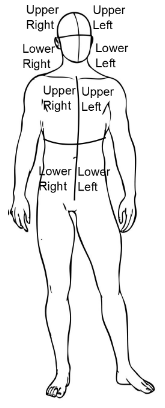Openings
4 Openings (high/low)
The four openings are a common part to most of the German fencing tradition. In essence there are four main openings based on a division of the target into quadrants.
Meyer uses the standard division of the target into these quadrants throughout his text, though augments it by further dividing the target as needed into quadrants for particular target regions. Whereas earlier masters divided the body into a simple four quarters (upper left, upper right, lower left, lower right) Meyer also divides the head into four quarters so that we can strike to the lower left opening of the head, or the upper right of the head. He does also use a more generic four openings in his Dussack section; in this case the centrepoint for the four openings is around neck level for the target. The remaining sections on rappier, dagger, and polearms, use the same openings as the longsword and dussack sections.
One can speculate that this represents a focus on blows to the head in 16th century fechtschulen as a means of “scoring”, though it may simply be a natural extension of older terminology to provide more accuracy/precision in practice.
Notice that the openings are specified from the point of view of the target's frame of reference, so the upper left opening referred to the target's upper left, rather than the upper left from the point of view of the attacker.
Attacking the Four Openings
In his section on the Meyer Square (more accurately his section on how one should attack the four openings) Meyer briefly describes general principles for attacking the openings. He favours attacking on opposite diagonals in the onset. So for example if the fencer attacks to the upper left opening initially, then they should immediately strike to the lower right opening afterward as a general principle (depending on the circumstance of course).
The rationale here is that the opponent has had to go up again this high blow so will have left the lower opening unguarded in doing so.
From here Meyer changes off to the opposite side on the same level (so in our example he would follow with a cut to the lower left), then again to the opposite diagonal at the newly created opening (the upper right in this case).
So as a general rule attacking the openings is carried out as follows:
- Attack an opening
- Attack the opening on the opposite diagonal to the previous strike
- Attack the other side on the same level as the previous strike
- Attack the opening on the opposite diagonal to the previous strike
This is demonstrated in the Attacking to the Openings Device 127v.1.
Attacking the Opponent's Openings after they Cut
Just as we can attack the openings in the onset, Meyer also points out that we should follow similar principles when chasing an opponent after an attack (Nachreisen). This should follow the general rule of opposite diagonals as seen before, however in this case the fencer is attacking the opposite diagonal to the opening in which the opponent's blade ends its motion.
For example, if the opposing fencer cuts a Zornhauw from his upper right all the way through to wechsel on the left they end with their sword in the lower left quadrant. We should immediately then attack the upper right opening in response as this is at the furthest extend from the opponent's sword, and requires a complete change of direction of their blade in order to parry.
Of course, these are general rules and as the devices teach us they are used judiciously at the correct moment, rather than adhered to dogmatically.
